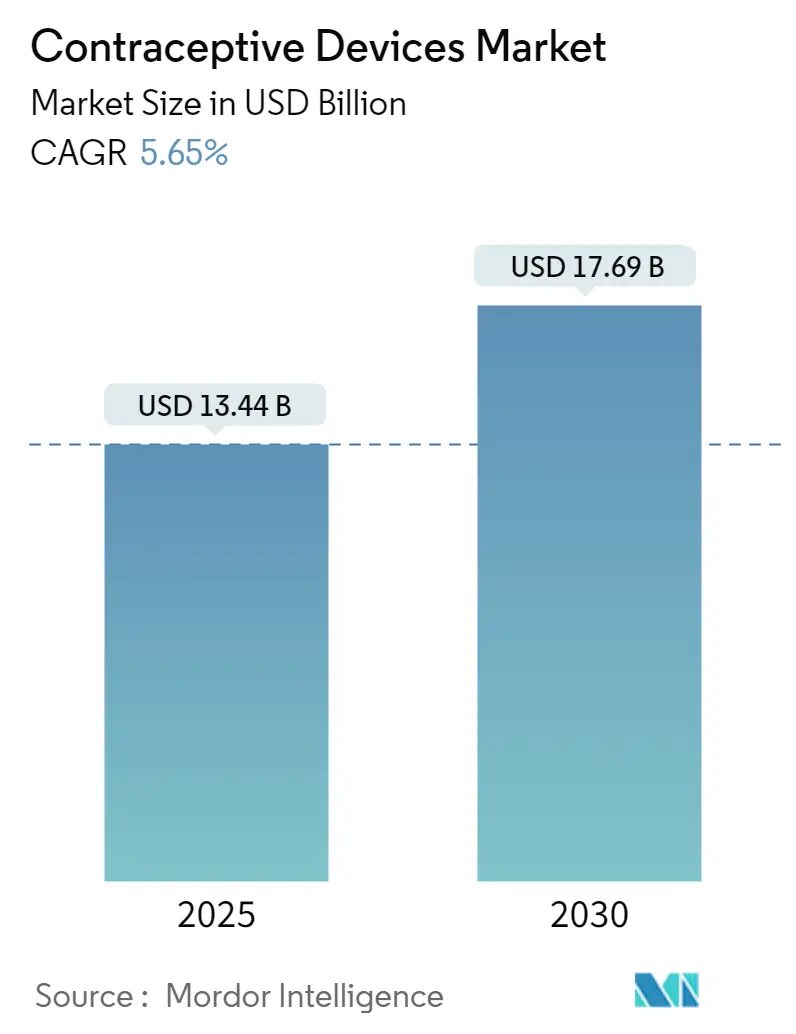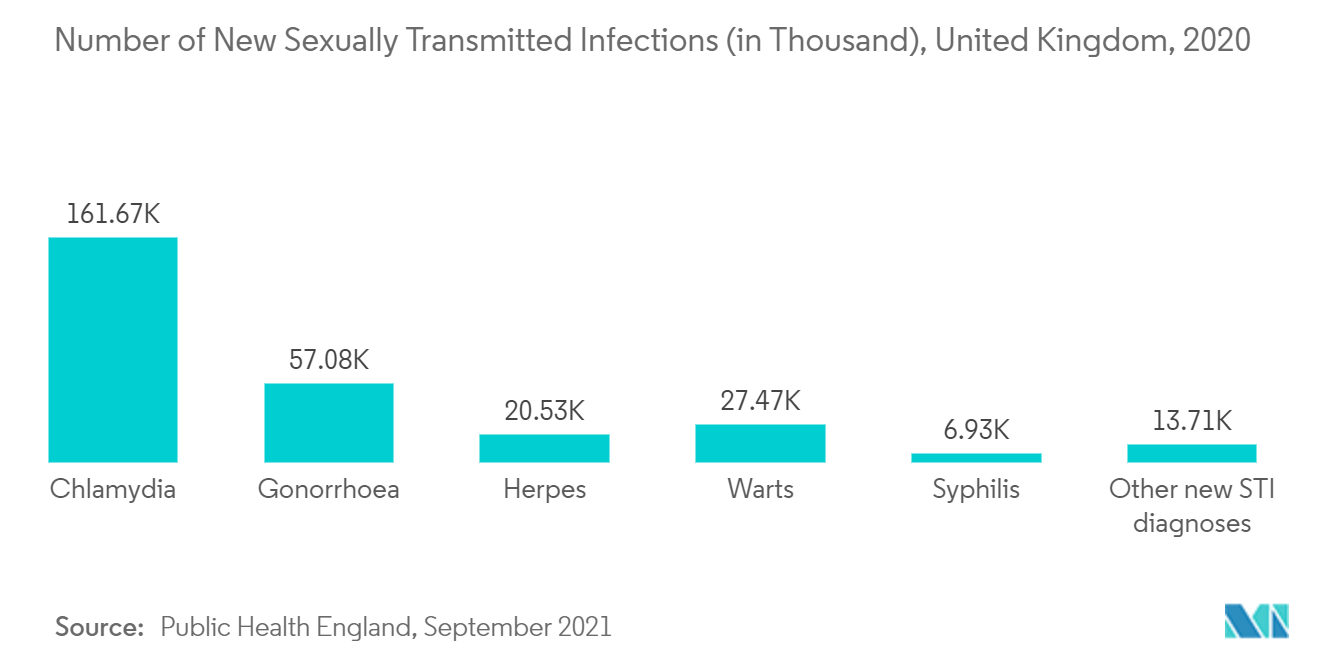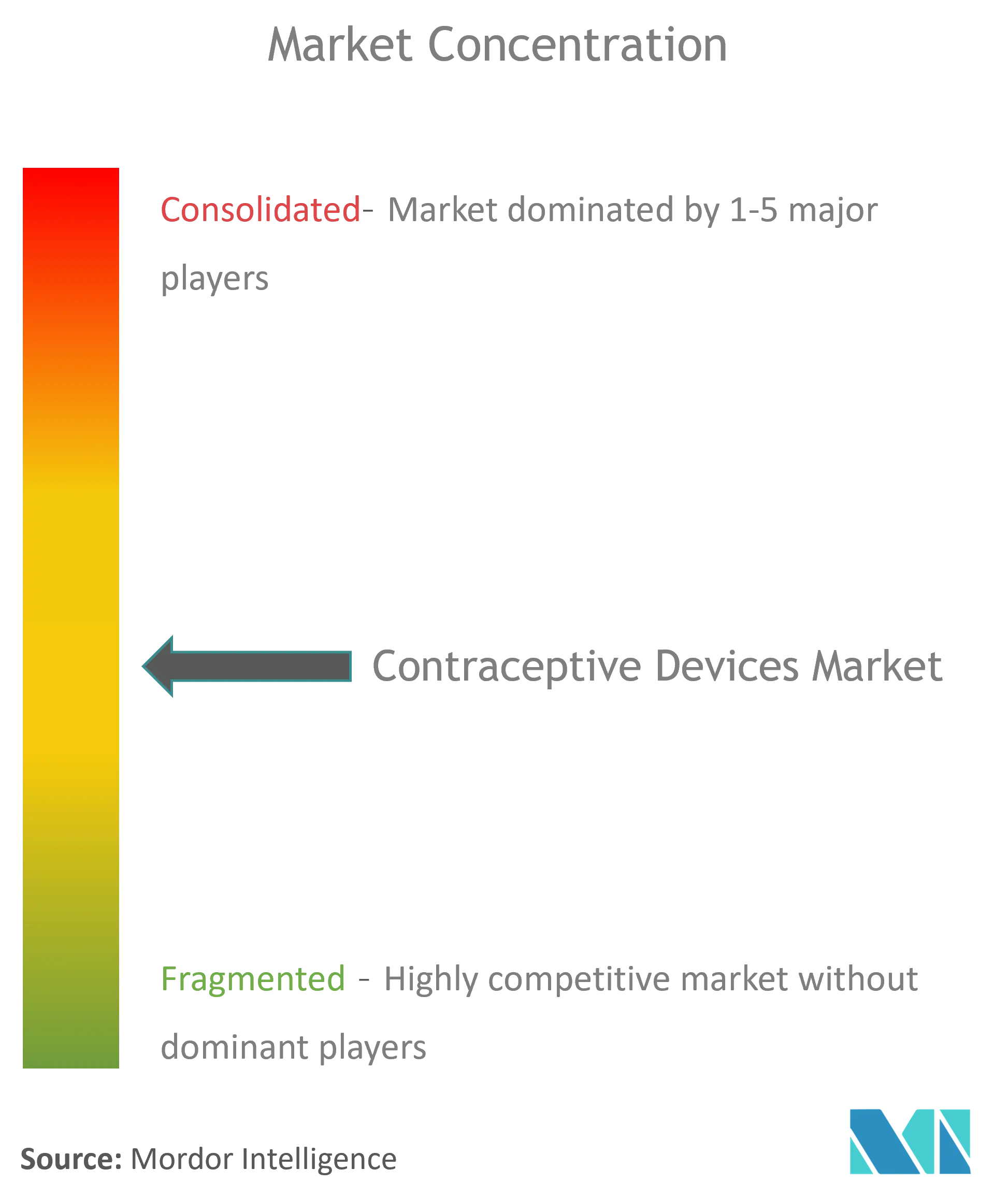
Contraceptive Devices Market Analysis
The Contraceptive Devices Market size is estimated at USD 13.44 billion in 2025, and is expected to reach USD 17.69 billion by 2030, at a CAGR of 5.65% during the forecast period (2025-2030).
The COVID-19 pandemic has impacted the growth of the studied market. Initially, the global COVID-19 outbreak and the lockdown scenario in the country have imposed some challenges on the market, as hospitals and clinics were forced to suspend services to prevent the spread of the SARS-CoV-2 virus. The restrictions imposed by the government have significantly impacted the growth of the studied market during the initial period of the pandemic. For instance, according to an article published in March 2022, titled 'Effect of the COVID-19 pandemic on contraceptive prescribing in general practice: a retrospective analysis of English prescribing data between 2019 and 2020', it has been observed that the use of long-acting contraceptives decreased, with implants by 76%, intrauterine systems by 79% and intrauterine devices by 76%. However, with the released COVID-19 restrictions and resumed services, the studied market is expected to grow over the forecast period.
Certain factors that are propelling the market growth are increasing awareness about sexually transmitted diseases, the rising rate of unintended pregnancies, and growing government initiatives.
Unwanted pregnancies are becoming more prevalent globally and are a major cause for concern. For instance, according to the United Nations Population Fund, in March 2022, unintended pregnancies accounted for about half of all pregnancies worldwide, with 121 million occurring each year. As per the same source, over 60% of unplanned pregnancies end in abortion, with an estimated 45% of all abortions being unsafe, resulting in 5%-13% of all maternal fatalities, putting the world's capacity to meet the "Sustainable Development Goals" at risk. Thus, the high rate of unintended pregnancies and unsafe abortions are expected to increase the demand for contraceptive devices, which in turn is anticipated to propel market growth.
In addition, the rising prevalence of sexually transmitted diseases among the population is expected to increase market growth. For instance, according to the report published by the Centers for Disease Control and Prevention in April 2022, it reported that around 133,945 cases of all stages of syphilis were noted,which includes 41,655 cases of primary and secondary syphilis which is considered the most infectious stages of the disease. It also reported an increase of 6.8% in Syphilis during the period 2019 to 2020. The same report also indicated that around 2,148 cases of congenital syphilis were reported in 2020, which includes 149 congenital syphilis-related stillbirths and infant deaths. Additionally, according to the data published by the World Health Organization, in November 2021, it has been observed that around 374 million new infections with one of four sexually transmitted diseases - chlamydia (129 million), gonorrhea (82 million), syphilis (7.1 million) and trichomoniasis (156 million) were recorded in 2020. Thus, the rising burden of sexually transmitted diseases is expected to increase the demand for contraception to avoid getting diseases, thereby propelling market growth.
However, the side effects associated with the use of contraceptive devices are likely to impede the market growth over the forecast period.
Contraceptive Devices Market Trends
Female Segment is Expected to Dominate the Contraceptive Devices Market Over the Forecast Period
The female segment in the contraceptive devices market is expected to witness significant growth over the forecast period owing to the increased adoption of contraceptive devices, rising sexually transmitted diseases, and a growing number of unintended pregnancies.
According to an article published by the Journal of Family Medicine and Primary Care, in June 2021, titled 'A study on contraceptive prevalence rate and factors influencing it in a rural area of Coimbatore, South India', the contraceptive prevalence rate was found to be 75%. The most used contraceptive methods were tubectomy (81.6%), and intrauterine devices (6.3%). In addition, as per the same source, the use of contraception was found to be statistically significantly correlated with the women's older age, religion, educational status, socioeconomic status, employment status, number of living children, age at marriage, and age at first childbirth.
Additionally, according to an article published by BioMed Central, in January 2020, titled 'Exploring young women's reasons for adopting intrauterine or oral emergency contraception in the United States: a qualitative study', it has been observed that emergency intra-uterine devices are important and acceptable options among women owing to their benefits.
Furthermore, the increasing company focus on adopting various business strategies such as product launches, listing products in the countries, mergers, and company spin-offs are likely to boost the growth of the market over the forecast period. For instance, In January 2022, Organon announced the public listings for NEXPLANON (etonogestrel extended-release subdermal implant) in Ontario (Ontario Drug Benefit Program), British Columbia (BC PharmaCare), and Nova Scotia (Nova Scotia PharmaCare).
Similarly, in November 2021, Organon announced the public listings for NEXPLANON (etonogestrel extended-release subdermal implant) in Quebec under the Régie de l'assurance Maladie du Québec (RAMQ). Similarly, in June 2021, Sebela Pharmaceuticals Inc., in collaboration with PRA Health Sciences is conducted phase III clinical trial to assess LevoCept, a long-acting reversible intrauterine system for contraceptive efficacy, safety, and tolerability.
Thus, owing to the aforementioned factors, the market is expected to grow significantly during the forecast period.

North America is Expected to Dominate the Contraceptive Devices Market Over the Forecast Period
North America is expected to dominate the contraceptive devices market over the forecast period owing to the factors such as the rising cases of unwanted pregnancies and high abortion rates, the presence of sophisticated healthcare infrastructure, the high adoption rate of contraceptive devices, and the rising number of government initiatives.
In addition, the rising number of sexually transmitted diseases among the population in the region is also contributing to the growth of the market in the region. For instance, in April 2022, a report published by the Centers for Disease Control and Prevention (CDC) titled 'Sexually Transmitted Disease Surveillance, 2020', stated that STDs remain a significant public health concern in the United States. According to the same source, Chlamydia trachomatis infection was the most prevalent notifiable sexually transmitted infection in the United States in 2020 with a total of 1,579,885 cases reported to the Centers for Disease Control and Prevention (CDC). In addition, as per the same source, 677,769 different gonorrhea infections were reported in the United States, in 2020. Thus, the rising burden of these diseases among the population is expected to increase the demand for male condoms which protect against pathogens such as gonorrhea, herpes simplex virus (HSV), hepatitis B, HIV, and chlamydia which are expected to propel the market growth in the region over the forecast period.
Furthermore, several organizations are also engaged in the implementation of strategic initiatives in the country. For instance, as per the Bill and Melinda Gates Foundation data published in 2022, the foundation is aiming to offer USD 280 million per year from 2021 to 2030 for developing new and improved contraceptive technologies, support family planning programs that reflect the preferences of local communities and enable women and girls to be in control of their contraceptive care.
Thus, owing to the aforementioned factors, the market is expected to grow significantly during the forecast period.

Contraceptive Devices Industry Overview
The contraceptive devices market is fragmented with the presence of key market players. The majority of the contraceptive devices are being manufactured by the global key players. Market leaders with more funds for research and a better distribution system have established their position in the market studied. Moreover, Asia-Pacific has been witnessing the emergence of some small players due to the rise of awareness. This has also helped the studied market to grow.Some of the key players in the market are AbbVie (Allergan PLC), Bayer AG, Cooper Surgical Inc., Reckitt Benckiser, Pregna International Limited and Teva Pharmaceutical Industries Ltd.
Contraceptive Devices Market Leaders
-
Pregna International Limited
-
Cooper Surgical Inc.
-
Reckitt Benckiser Group PLC
-
Bayer AG
-
AbbVie (Allergan PLC)
- *Disclaimer: Major Players sorted in no particular order
Contraceptive Devices Market News
In April 2022, ProMed Pharma began preclinical evaluation of a novel fully resorbable contraceptive implant after getting the funds from Bill and Melinda Gates Foundation.
In February 2022, Mithra and Searchlight Pharma launched Myring, Mithra's vaginal contraceptive ring, under the brand name Haloette in Canada.
Contraceptive Devices Industry Segmentation
As per the scope of the report, contraceptive devices have been barriers that attempt to prevent pregnancy by physically preventing sperm from entering the uterus. Contraception is more commonly known as fertility, and birth control is described as the method used to avoid pregnancy. They include male condoms, female condoms, cervical caps, diaphragms, and contraceptive sponges with spermicide. The Contraceptive Devices Market is segmented by Type (Condoms, Diaphragms, Cervical Caps, Sponges, Vaginal Rings, Intra Uterine Device (IUD), and Other Types), Gender (Male and Female), and Geography (North America, Europe, Asia-Pacific, Middle East and Africa, and South America). The market report also covers the estimated market sizes and trends for 17 different countries across major regions globally. The report offers the value (in USD million) for the above segments.
| By Type | Condoms | ||
| Diaphragms | |||
| Cervical Caps | |||
| Sponges | |||
| Vaginal Rings | |||
| Intra Uterine Device (IUD) | |||
| Other Types | |||
| By Gender | Male | ||
| Female | |||
| Geography | North America | United States | |
| Canada | |||
| Mexico | |||
| Europe | Germany | ||
| United Kingdom | |||
| France | |||
| Italy | |||
| Spain | |||
| Rest of Europe | |||
| Asia-Pacific | China | ||
| Japan | |||
| India | |||
| Australia | |||
| South Korea | |||
| Rest of Asia-Pacific | |||
| Middle East & Africa | GCC | ||
| South Africa | |||
| Rest of Middle East & Africa | |||
| South America | Brazil | ||
| Argentina | |||
| Rest of South America | |||
Contraceptive Devices Market Research FAQs
How big is the Contraceptive Devices Market?
The Contraceptive Devices Market size is expected to reach USD 13.44 billion in 2025 and grow at a CAGR of 5.65% to reach USD 17.69 billion by 2030.
What is the current Contraceptive Devices Market size?
In 2025, the Contraceptive Devices Market size is expected to reach USD 13.44 billion.
Who are the key players in Contraceptive Devices Market?
Pregna International Limited, Cooper Surgical Inc., Reckitt Benckiser Group PLC, Bayer AG and AbbVie (Allergan PLC) are the major companies operating in the Contraceptive Devices Market.
Which is the fastest growing region in Contraceptive Devices Market?
Asia Pacific is estimated to grow at the highest CAGR over the forecast period (2025-2030).
Which region has the biggest share in Contraceptive Devices Market?
In 2025, the North America accounts for the largest market share in Contraceptive Devices Market.
What years does this Contraceptive Devices Market cover, and what was the market size in 2024?
In 2024, the Contraceptive Devices Market size was estimated at USD 12.68 billion. The report covers the Contraceptive Devices Market historical market size for years: 2019, 2020, 2021, 2022, 2023 and 2024. The report also forecasts the Contraceptive Devices Market size for years: 2025, 2026, 2027, 2028, 2029 and 2030.
Our Best Selling Reports
Contraceptive Devices Industry Report
Statistics for the 2025 Contraceptive Devices market share, size and revenue growth rate, created by Mordor Intelligence™ Industry Reports. Contraceptive Devices analysis includes a market forecast outlook for 2025 to 2030 and historical overview. Get a sample of this industry analysis as a free report PDF download.




